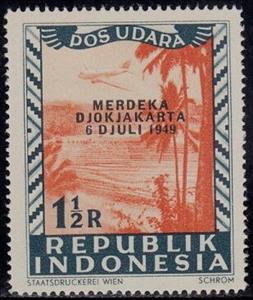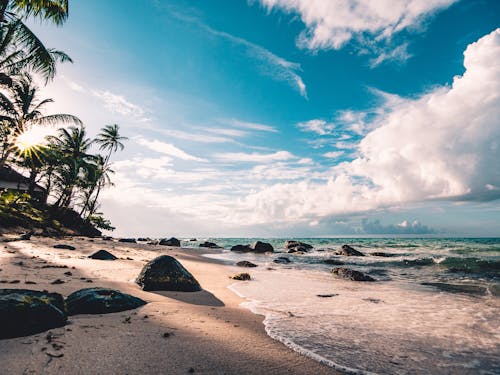Stamp: DC-3 Over Rice Fields (Indonesia 1949)
DC-3 Over Rice Fields (Indonesia 1949)
01 January (Indonesia ) within release Vienna Printings - RepUblik - Merdeka goes into circulation Stamp DC-3 Over Rice Fields face value 1½ Indonesian rupiah
| Stamp DC-3 Over Rice Fields in catalogues | |
|---|---|
| Dai Nippon: | Dai: ID 28-08b |
Stamp is square format.
Overprint Type 2: The length of 6 DJULI 1949 is 13 mm. and is characterized by the "6" standing directly under the "J" of DJOKJAKARTA.Also in the issue Vienna Printings - RepUblik - Merdeka:
- Stamp - Dancer - Overprint face value 5;
- Stamp - Road construction - Overprint face value 3½;
- Stamp - Temple picture - Overprint face value 2;
- Stamp - Dancer overprinted face value 5;
- Souvenir Sheet - Map of Indonesia and Ships overprinted face value 1.10;
- Souvenir Sheet - Map of Indonesia and Ships overprinted face value 1.10;
- Stamp - Overpint "MERDEKA / DJOKJAKARTA / 6 DJULI 1949" face value 20;
- Stamp - Overpint RESMI "MERDEKA / DJOKJAKARTA / 6 DJULI 1949" face value 15;
- Stamp - Overpint RESMI "MERDEKA / DJOKJAKARTA / 6 DJULI 1949" face value 10;
- Stamp - Overpint RESMI "MERDEKA / DJOKJAKARTA / 6 DJULI 1949" face value 50;
- Stamp - Overpint RESMI "MERDEKA / DJOKJAKARTA / 6 DJULI 1949" face value 30;
- Stamp - Overpint RESMI "MERDEKA / DJOKJAKARTA / 6 DJULI 1949" face value 30;
- Stamp - Overpint RESMI "MERDEKA / DJOKJAKARTA / 6 DJULI 1949" face value 50;
- Stamp - Plane over Sumatra Mountain overprint face value 1;
- Stamp - President Soekarno Decorates a Soldier overprinted face value 2;
- Souvenir Sheet - Ship and airplane face value 5.50;
- Stamp - Airplane face value 30;
- Stamp - Airplane and flag face value 4½;
- Stamp - Airplane and flag face value 4½;
- Stamp - Airplane and flag face value 4½;
- Stamp - Airplane over the Archipelago face value 10;
- Stamp - Airplane over the Archipelago face value 10;
- Stamp - Airplanes Breaking the Blockade face value 50;
- Stamp - Airplanes Breaking the Blockade face value 50;
- Stamp - Airplanes Breaking the Blockade face value 50;
- Stamp - Batik Worker face value 2½;
- Stamp - Blockade Airplane face value 2½;
- Stamp - Blockade Airplane face value 2½;
- Stamp - Blockade Airplane face value 2½;
- Stamp - Blockade Issues face value 1;
- Stamp - Blockade Issues face value 1;
- Stamp - Blockade Issues face value 1;
- Stamp - Boy with ananas face value 35;
- Stamp - Buffalo canyon face value 15;
- Stamp - Buffalo canyon face value 15;
- Stamp - Dancer face value 5;
- Stamp - Dancer face value 60;
- Stamp - Dancer face value 5;
- Stamp - Dancer face value 50;
- Stamp - DC-3 Over Rice Fields face value 1½;
- Stamp - Discussing Pilots face value 50;
- Stamp - Discussing Pilots face value 50;
- Stamp - Fighting Illiteracy face value 1;
- Stamp - Harbor Scene face value 1;
- Stamp - Harbor Scene face value 1;
- Stamp - Harbor Scene face value 1;
- Stamp - Harbor scene face value 30;
- Stamp - Harbor scene face value 30;
- Stamp - Harbor scene face value 30;
- Stamp - Healthcare face value 10;
- Stamp - Healthcare face value 10;
- Stamp - Hot Springs, Java face value 7½;
- Stamp - Landscape with palm and water face value 40;
- Stamp - Map of Indonesia face value 2½;
- Stamp - Metal Worker face value 3;
- Stamp - Mosque in Medan face value 80;
- Stamp - Mountain, Sumatra face value 30;
- Stamp - Mountain, Sumatra face value 30;
- Stamp - Peasant face value 4;
- Stamp - Pilots face value 40;
- Stamp - Plane over Buffalo Canyon face value 4½;
- Stamp - Plane over Sumatra Mountain face value 1;
- Stamp - Plane over Sumatra Mountain face value 1;
- Stamp - Plowing with buffalos face value 17½;
- Stamp - President Soekarno Decorates a Soldier face value 2;
- Stamp - President Soekarno Decorates a Soldier face value 2;
- Stamp - Rice farmers face value 20;
- Stamp - Rice planting face value 7½;
- Stamp - Road Construction face value 3½;
- Stamp - Ships Breaking the Blockade face value 10;
- Stamp - Ships Breaking the Blockade face value 25;
- Stamp - Ships Breaking the Blockade face value 10;
- Stamp - Ships Breaking the Blockade face value 10;
- Stamp - Ships Breaking the Blockade face value 25;
- Stamp - Ships Breaking the Blockade face value 25;
- Stamp - Soldier on Guard face value 1;
- Stamp - Special services (Expres) face value 10;
- Stamp - Special services (Expres) face value 15;
- Stamp - Special Services (Pos Udara Expres) face value 40;
- Stamp - Temple picture face value 2;
- Stamp - Unloading of a Blockade Vessel face value 15;
- Stamp - Unloading of a Blockade Vessel face value 60;
- Stamp - Unloading of a Blockade Vessel face value 15;
- Stamp - Unloading of a Blockade Vessel face value 15;
- Stamp - Unloading of a Blockade Vessel face value 60;
- Stamp - Unloading of a Blockade Vessel face value 60;
- Stamp - Warplane face value 30;
- Stamp - Watching soldier face value 75;
- Stamp - Woman Dancer face value 50;
- Stamp - Workers and Airplane face value 20;
Stamp DC-3 Over Rice Fields it reflects the thematic directions:
An aircraft (pl. aircraft) is a vehicle that is able to fly by gaining support from the air. It counters the force of gravity by using either static lift or the dynamic lift of an airfoil, or, in a few cases, direct downward thrust from its engines. Common examples of aircraft include airplanes, rotorcraft (including helicopters), airships (including blimps), gliders, paramotors, and hot air balloons.Part 1 (Definitions and Abbreviations) of Subchapter A of Chapter I of Title 14 of the U. S. Code of Federal Regulations states that aircraft "means a device that is used or intended to be used for flight in the air."
Aviation is the practical aspect or art of aeronautics, being the design, development, production, operation and use of aircraft, especially heavier than air aircraft. The word aviation was coined by French writer and former naval officer Gabriel La Landelle in 1863, from the verb avier (synonymous flying), itself derived from the Latin word avis ("bird") and the suffix -ation.
A landscape is the visible features of an area of land, its landforms and how they integrate with natural or man-made features. A landscape includes the physical elements of geophysically defined landforms such as (ice-capped) mountains, hills, water bodies such as rivers, lakes, ponds and the sea, living elements of land cover including indigenous vegetation, human elements including different forms of land use, buildings and structures, and transitory elements such as lighting and weather conditions. Combining both their physical origins and the cultural overlay of human presence, often created over millennia, landscapes reflect a living synthesis of people and place that is vital to local and national identity. The character of a landscape helps define the self-image of the people who inhabit it and a sense of place that differentiates one region from other regions. It is the dynamic backdrop to people’s lives. Landscape can be as varied as farmland, a landscape park, or wilderness. The earth has a vast range of landscapes, including the icy landscapes of polar regions, mountainous landscapes, vast arid desert landscapes, islands and coastal landscapes, densely forested or wooded landscapes including past boreal forests and tropical rainforests, and agricultural landscapes of temperate and tropical regions.
The Arecaceae is a family of perennial, flowering plants in the monocot order Arecales. Their growth form can be climbers, shrubs, tree-like and stemless plants, all commonly known as palms. Those having a tree-like form are called palm trees. Currently, 181 genera with around 2,600 species are known,
most of which are restricted to tropical and subtropical climates. Most palms are distinguished by their large, compound, evergreen leaves, known as fronds, arranged at the top of an unbranched stem, except for the Hyphaene genus, who has branched palms. However, palms exhibit an enormous diversity in physical characteristics and inhabit nearly every type of habitat within their range, from rainforests to deserts.
Flora is the plant life occurring in a particular region or time, generally the naturally occurring or indigenous—native plant life. The corresponding term for animal life is fauna. Flora, fauna and other forms of life such as fungi are collectively referred to as biota. Sometimes bacteria and fungi are also referred to as flora, as in the terms gut flora or skin flora.
A sea is a large body of salty water. There are particular seas and the sea. The sea commonly refers to the World Ocean, the wider body of seawater. Particular seas are either marginal seas, second-order sections of the oceanic sea (e.g. the Mediterranean Sea), or certain large, nearly landlocked bodies of water.






